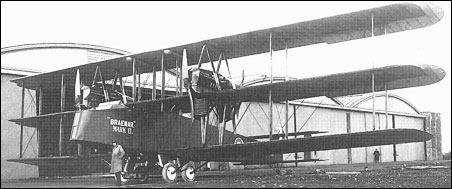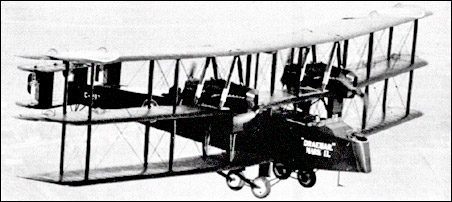|
| An unsuccessful contender for a 1917 large bomber requirement, the
Bristol Braemar triplane formed the basis of the Pullman, an equally
unwanted airliner with a large cabin and enclosed cockpit. The Pullman's
crew distrusted this feature and took to carrying axes with which to hack
their way out in an emergency.
The Royal Mail Steam Packet Company showed interest in a version called
the Tramp to be powered (naturally) by steam engines. By 1919 this was
pretty eccentric and a considerable challenge. Two Tramps were built, each
with four piston engines in an internal engine room while a light and
powerful steam powerplant was developed. This proved impossible, as did
making the system that transmitted power from engine room to propellers
work reliably, and thus neither of the Tramps ever flew.
| MODEL | Braemar Mark II |
| CREW | 6 |
| ENGINE | 4 x 410hp Liberty 12A water-cooled in-line engines |
| WEIGHTS |
| Take-off weight | 8399 kg | 18517 lb |
| Empty weight | 4835 kg | 10659 lb |
| DIMENSIONS |
| Wingspan | 24.89 m | 82 ft 8 in |
| Length | 15.70 m | 52 ft 6 in |
| Height | 6.30 m | 21 ft 8 in |
| Wing area | 176.98 m2 | 1905.00 sq ft |
| PERFORMANCE |
| Max. speed | 201 km/h | 125 mph |
| Ceiling | 5182 m | 17000 ft |
| ARMAMENT | 5 x 7.7mm machine-guns, 6 x 100kg bombs |
 | A three-view drawing of Braemar II (600 x 266) |
| Anonymous, 01.01.2023 08:57 'By 1919 this was pretty eccentric and a considerable challenge'
Thats an understatement! Have there been any other attempts to build an aircraft powered by steam engines? reply |
|
Do you have any comments?
|
| 
COMPANY
PROFILE
All the World's Rotorcraft
|








